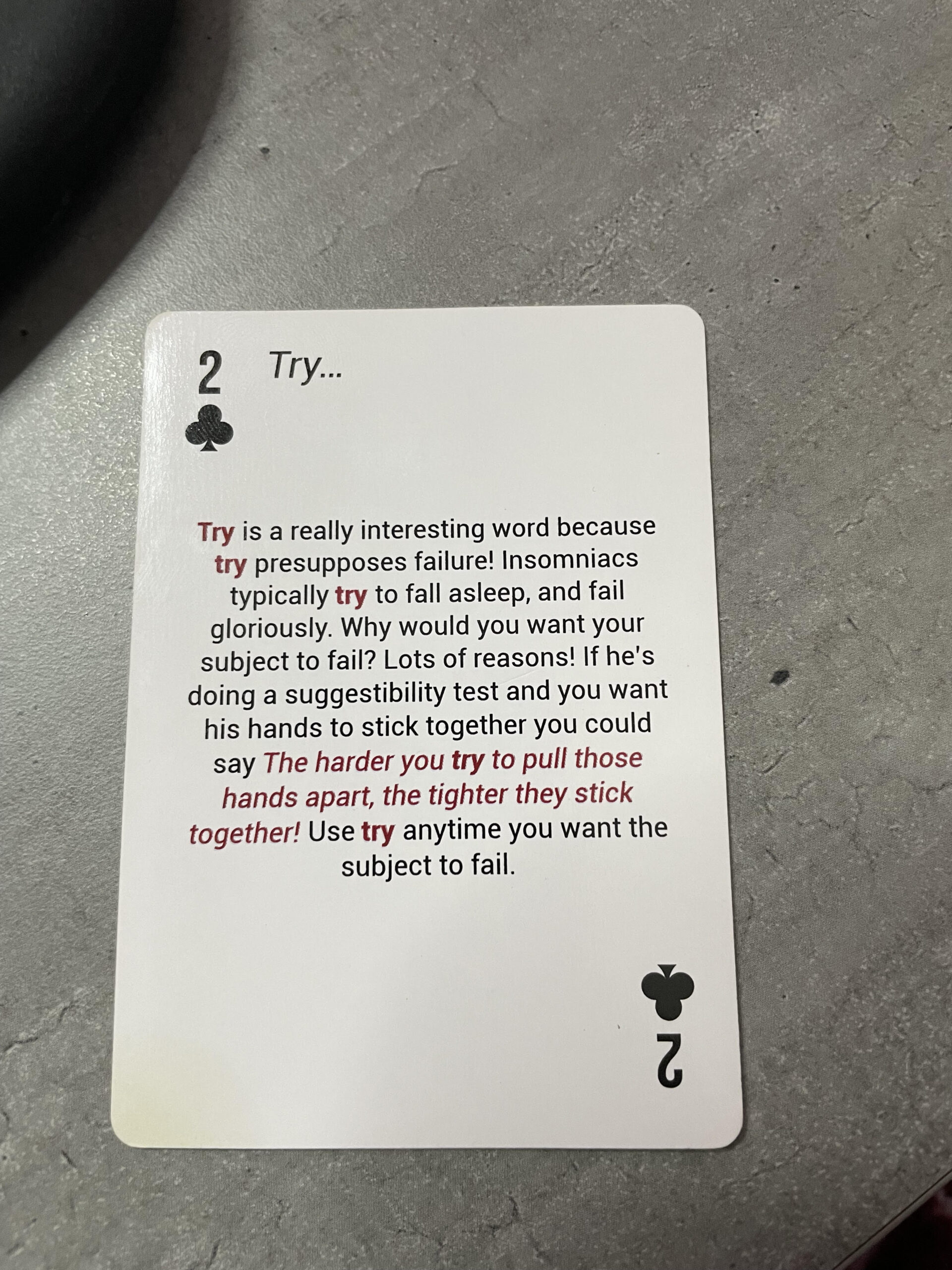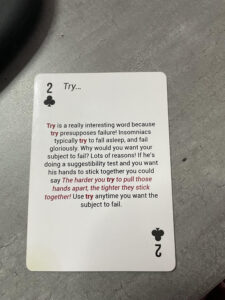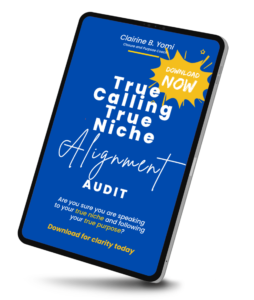Why “Trying” is Holding You Back—and What to Do Instead
Have you ever paused to consider the true power of words? Words shape our perceptions, ignite our actions, and sometimes sabotage our success without us even realizing it. Among them, one innocuous word derails progress more than most—try.
Though often used with the best intentions, try has become a habitual linguistic crutch, a subconscious self-sabotage embedded in our daily lives. In hypnosis, it carries an entirely different weight—one designed not to empower but to ensure failure.
The Hidden Trap in “Trying”
In the world of hypnosis, the word try is no accident; it’s a deliberate tool to evoke resistance. When a hypnotist says, “Try to lift your hand, and you’ll find you can’t,” they are harnessing the subconscious power of this word to create a block. Try implies effort with an expectation of failure—like pushing against a locked door without ever expecting it to open.
But this pattern is not confined to hypnosis sessions. It infiltrates our daily self-talk, quietly dictating outcomes. Think about it:
- “I’ll try to make it to the gym tomorrow.”
- “I’m trying to figure out my purpose.”
- “I’ll try to start that project soon.”
These sentences, while sounding proactive, are laden with doubt. They lack the conviction needed to inspire action. When we tell ourselves we’ll try, what we’re really saying is, “I’ll attempt, but it’s okay if I don’t succeed.” The subconscious hears the doubt and takes it as permission to stall.
Why Try Is a Program of Inaction
Let’s break this down with a simple metaphor. Imagine you’re standing at a crossroads. One path is well-lit and direct—marked do. The other is shadowy, winding, and marked try. Which would you trust to get you to your destination?
The act of “trying” exists in a no-man’s-land between intention and action. It’s like revving the engine of your car without ever putting it in gear. You feel the energy of effort, but you’re going nowhere. It’s a mental stalling tactic that exhausts your resources without producing results.
Now imagine someone saying, “I’ll try to lift this pen.” They either lift it, or they don’t. There is no actual act of trying. It’s a linguistic placeholder that creates an illusion of progress while keeping you stuck in limbo.
The Subconscious Commands of “Try”
Here’s where try becomes more than just a casual word—it becomes a self-programming tool. Words are the instructions we give to our subconscious, and our subconscious operates on clarity. When you say, “I’ll try to start my business,” your subconscious hears, “This might not happen.” It shifts into neutral gear, keeping you in a loop of preparation without execution.
The only time try holds power is in the past tense: “I tried.” Here, it reflects an attempt made and a lesson learned, regardless of the outcome. But in the present or future tense, try is a hypnotic suggestion that ensures hesitation and procrastination.
The word try has many synonyms like “attempt,” “test,” or “experiment,” but it’s important to understand how these differ from doing. While try involves effort, it often lacks the full commitment or power of intention needed to create meaningful results. When we say we’ll try to do something, it’s like we’re leaving the door open for failure. It’s a tentative step, as if we’re unsure whether success is possible. Words like “test” or “attempt” carry the same sense of uncertainty—they suggest we’re only half-invested in the outcome. In contrast, doing is powered by intention, determination, and purpose.
When you say, “I’ll try to exercise tomorrow,” you give yourself an easy way out. The word try doesn’t command your subconscious to take action; instead, it creates a mental escape hatch. It’s as if you’re saying, “I might exercise, but it’s okay if I don’t.” Without the power of intention, the effort becomes hollow. Compare that to saying, “I will exercise tomorrow.” That simple shift changes everything. It commits you to action, creating a sense of inevitability. You’re not just attempting to do something—you’re doing it.
Mandel Card
The history of the word try reflects this lack of certainty. By the 14th century, it was used to mean “attempt,” a word that also implies effort without guarantee. By the 1540s, try came to mean “test,” as in experimenting to see if something works. This sense of exploration can be useful in some contexts, like testing a theory or trying out a new idea. However, even in these cases, the act of trying is temporary and lacks finality. It’s like dipping your toe in the water instead of diving in. By the 1840s, the word also referred to checking if something is secure, like testing whether a window is locked. While useful, this meaning of try remains cautious and exploratory—not definitive or action-driven.
True progress comes when we move from trying to doing. Trying is powered by hesitation, but doing is powered by intention. When you act with intention, you set a clear goal and commit to achieving it, no matter the obstacles. Saying, “I will finish my project today” creates an entirely different mindset than, “I’ll try to finish my project.” The first statement carries the weight of certainty, while the second leaves room for procrastination or excuses.
This difference matters because our words shape our actions and outcomes. The words we use send messages to our subconscious minds, influencing how we perceive challenges and opportunities. When we say we’ll try, our subconscious hears doubt. But when we say we’ll do, it hears confidence and conviction. That mental clarity propels us forward, making success not just possible but inevitable.
Breaking Free from the Try Loop
If try is the bridge to nowhere, the antidote is clarity and commitment. Imagine replacing try with decisive, action-oriented language:
- “I’ll try to exercise tomorrow” becomes “I will exercise tomorrow.”
- “I’m trying to figure out my purpose” transforms into “I am discovering my purpose.”
These small linguistic shifts hold immense power. They anchor you in action, align your words with your intent, and signal to your subconscious that success is inevitable. Your mind thrives on certainty. When you declare will instead of try, you’re building momentum with every word.
So, the next time you catch yourself saying, “I’ll try,” pause and reframe. Replace try with do. Let your words reflect your intention and watch how they transform your results. After all, progress doesn’t come from attempting—it comes from taking action and doing what needs to be done.
From Hypnosis to Higher Alignment
In purpose-driven coaching, the language we use shapes not only our actions but the path we walk. Words are like seeds; they grow into the actions, habits, and outcomes that define our lives. In hypnosis, try is the seed of failure. In life, it’s no different.
As a Closure and Purpose Coach, my work revolves around helping individuals uncover their true calling and identify their niche through the clues their soul provides. This journey requires clarity, commitment, and decisive action. There is no room for try.
Imagine your soul leaving breadcrumbs—your passions, experiences, and challenges—all pointing toward your unique purpose. But if you merely try to follow them, you risk losing sight of the path. By choosing to do, you put the power of intention to work and we align with the rhythm of your higher purpose and step boldly into your calling.
What Will You Choose?
Try is the hypnotic lullaby that keeps us asleep to our potential. To awaken, we must replace it with words of action and intention. Life is waiting for you to act, not merely to attempt.
So, what will it be? Will you try to change, or will you step boldly into action? Ready to break the spell of try and align with your true calling and true niche?
Get Started with the Alignment Audit Questionnaire
Your journey to alignment starts now. The Alignment Audit Questionnaire is designed to help you uncover the gaps between your current work and your true purpose. With simple, soul-centered prompts, it guides you to clarity, helping you:
- Discover whether you’re truly aligned with your purpose.
- Identify the gaps between your calling, your current audience and your current impact and your purposeful self.
- Discover areas to realign and move forward with confidence.
- Get the mot transformative tools for a deep realignment you could ever dream of.





This text really makes you think about how much of our energy is wasted in the process of “trying” rather than doing. It’s interesting how it compares this state to revving a car engine without moving forward—such a vivid image. It’s easy to get stuck in this mindset, feeling like we’re making an effort but actually going nowhere. Have you noticed this pattern in your own life? How do you move past that mental stalling and into action?
This pattern of mental stalling is something many of us experience daily without realizing it. The metaphor of revving a car engine without moving perfectly captures the frustration of effort without progress. It’s crucial to recognize this behavior to shift from intention to meaningful action. Finding purpose can be the key to breaking this cycle. What steps can we take to transition from “trying” to actually achieving our goals?